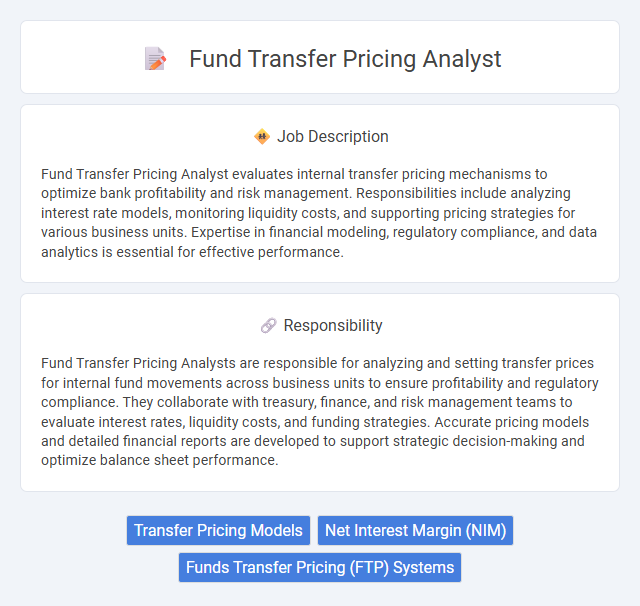
Fund Transfer Pricing Analyst evaluates internal transfer pricing mechanisms to optimize bank profitability and risk management. Responsibilities include analyzing interest rate models, monitoring liquidity costs, and supporting pricing strategies for various business units. Expertise in financial modeling, regulatory compliance, and data analytics is essential for effective performance.
Individuals with strong analytical skills and a keen attention to detail will likely find the Fund Transfer Pricing Analyst role well-suited to their abilities. Those comfortable working with complex financial data and models may excel in interpreting transfer pricing mechanisms within banking environments. Candidates who prefer structured, quantitative tasks over highly social or creative roles might have a higher probability of thriving in this position.
Qualification
A Fund Transfer Pricing Analyst requires strong expertise in financial analysis, risk management, and regulatory compliance within banking and investment environments. Proficiency in quantitative modeling, data interpretation using tools like SQL, Python, and Excel, along with a deep understanding of transfer pricing methodologies and interest rate risk, is essential. Candidates typically hold a degree in finance, economics, or related fields, coupled with certifications such as CFA or FRM to demonstrate advanced analytical and strategic skills.
Responsibility
Fund Transfer Pricing Analysts are responsible for analyzing and setting transfer prices for internal fund movements across business units to ensure profitability and regulatory compliance. They collaborate with treasury, finance, and risk management teams to evaluate interest rates, liquidity costs, and funding strategies. Accurate pricing models and detailed financial reports are developed to support strategic decision-making and optimize balance sheet performance.
Benefit
Fund Transfer Pricing Analysts likely provide valuable insights that could enhance a bank's profitability by accurately allocating costs and revenues across business units. Their expertise may improve decision-making processes by ensuring that internal pricing reflects true economic costs, potentially leading to more efficient capital usage. This role probably supports regulatory compliance and risk management, contributing to a more stable financial institution.
Challenge
Fund Transfer Pricing Analyst roles likely involve the challenge of accurately allocating costs and revenues across various business units while navigating complex regulatory requirements. The position probably demands a deep understanding of financial instruments and market dynamics to ensure precise pricing models. Managing large datasets and reconciling discrepancies may also present ongoing difficulties in maintaining data integrity and reporting accuracy.
Career Advancement
A Fund Transfer Pricing Analyst plays a critical role in financial institutions by assessing the cost of funds movement to optimize profitability and risk management. Mastery of advanced financial modeling, regulatory compliance, and interdepartmental collaboration paves the way for accelerated career advancement into senior analytics, treasury management, or strategic finance leadership roles. Expertise in data analytics and regulatory frameworks enhances prospects for high-impact positions such as Chief Financial Officer or Head of Asset-Liability Management.
Key Terms
Transfer Pricing Models
A Fund Transfer Pricing Analyst specializes in developing and maintaining Transfer Pricing Models to accurately allocate costs and revenues between business units and funding sources. These models leverage interest rate curves, market spreads, and liquidity premiums to reflect the economic value and risk of internal fund transfers. Expertise in quantitative analysis and financial modeling ensures optimized profitability assessment and regulatory compliance across funding operations.
Net Interest Margin (NIM)
A Fund Transfer Pricing Analyst plays a crucial role in optimizing Net Interest Margin (NIM) by accurately allocating interest income and expenses across business units based on internal funds transfer rates. This position involves analyzing asset and liability portfolios to ensure precise fund transfer pricing that supports profitability and strategic decision-making. Expertise in financial modeling and regulatory compliance is essential for maintaining accurate NIM measurements and enhancing overall financial performance.
Funds Transfer Pricing (FTP) Systems
Fund Transfer Pricing (FTP) Analysts specialize in managing and optimizing FTP systems to accurately allocate costs and revenues across banking units, ensuring precise interest rate risk management and profitability analysis. These professionals utilize advanced FTP software and data analytics tools to track internal funds movement, assess funding costs, and support strategic decision-making. Expertise in financial modeling, regulatory compliance, and cross-departmental collaboration is critical for maintaining efficient FTP system operations and enhancing an institution's balance sheet performance.
 kuljobs.com
kuljobs.com